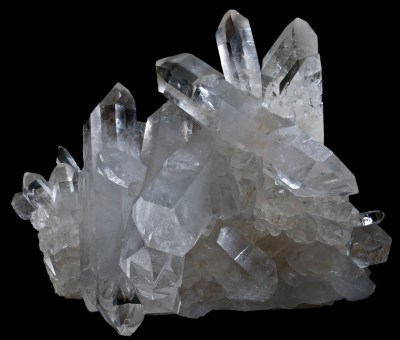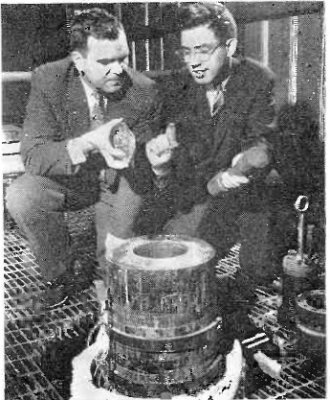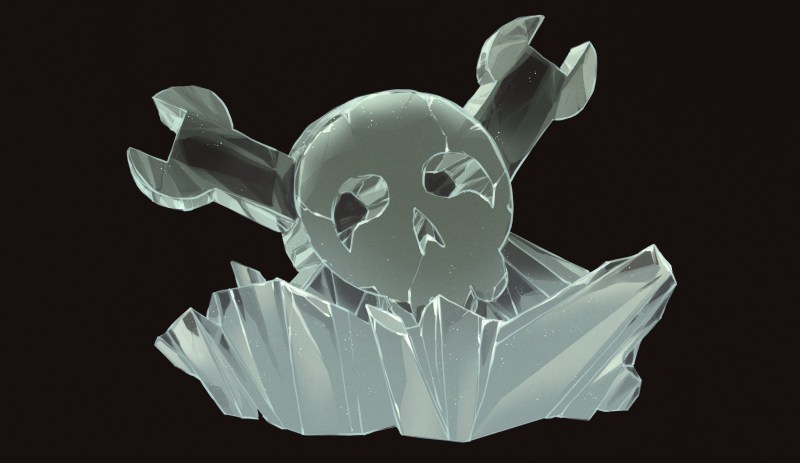So far in this series, pretty much every material we’ve covered has had to undergo a significant industrial process to transform it from its natural state to a more useful product. Whether it’s the transformation of bauxite from reddish-brown clay to lustrous aluminum ingots, or squeezing solid sulfur out of oil and natural gas, there haven’t been many examples of commercially useful materials that are taken from the Earth and used in their natural state.
Quartz, though, is at least a partial exception to this rule. Once its unusual electrical properties were understood, crystalline quartz was sent directly from quarries and mines to factories, where they were turned into piezoelectric devices with no chemical transformation whatsoever. The magic of crystal formation had already been done by natural processes; all that was needed was a little slicing and dicing.
As it turns out, though, quartz is so immensely useful for a technological society that there’s no way for the supply of naturally formed crystals to match demand. Like copper before it, which was first discovered in natural metallic deposits that could be fashioned into tools and decorations more or less directly, we would need to discover different sources for quartz and invent chemical transformations to create our own crystals, taking cues from Mother Nature’s recipe book on the way.
Crystals Everywhere

Pick up a rock almost anywhere on Earth and chances are pretty good that there’s at least some quartz in it. Quartz is the second-most abundant mineral in the continental crust, and is present both as visible crystals, ranging in size from immense outcroppings weighing tons down to the grains of beach sand, and as cryptocrystals so small you need a microscope to see them, which are hidden within other rocks, like flint.
Chemically, quartz is nearly pure silicon dioxide (SiO2). When there are no impurities, pure quartz is water-clear and often referred to as “rock crystal”. Impurities can give transparent quartz beautiful hues, such as yellowish citrine (iron) or rose quartz (titanium, iron, and manganese). Inclusions and trapped gasses can turn quartz translucent (milky quartz) and natural irradiation can even act on stray aluminum in the crystal matrix and turn it gray (smoky quartz).
Natural quartz crystals usually have a long body with a hexagonal cross-section with six-sided pyramidal caps on each end. Quartz crystal outcroppings can be found all over the world, with notable examples in the Ouachita Mountains of Arkansas, where rockhounds harvest crystals of often ridiculous proportions, and the Mohawk Valley in New York, where the misnamed “Herkimer Diamond” is found.
Aside from its aesthetic charms, and disregarding the claims of mysterious powers made by crystal enthusiasts, quartz has a lot of industrial uses. Its abundance of silicon makes it the perfect feedstock for silicon wafer production, and fused quartz glass of nearly pure silicon dioxide is used for everything from optical communication fibers to the crucibles used to melt silicon for the Czochralski method of growing monocrystalline silicon ingots.
Natural Isn’t Always Better
The piezoelectric effect, a property of certain crystals to vibrate at a characteristic frequency when a voltage is applied across them (and vice versa), has been known since the experiments of the Curie brothers in the 1880s, with quartz being one of the main crystals they focused on. Piezoelectricity first proved its utility in World War I, with submarine warfare and the need for ultrasonic transducers for sonar. Shortly after, the twin post-war explosions of radio and telephone increased the demand for quartz crystal oscillators. Almost all of the quartz needed for these components was harvested from natural crystals, mostly from Brazil and the quarries in Arkansas, from which raw slabs were painstakingly cut, polished, and processed to make finished piezoelectric components.

But then along came World War II, and the demand for natural quartz crystals exploded. Quartz was a critical material for prosecuting the war, and the supply of natural quartz was only barely keeping up with the demand, especially since crystals had to meet stringent requirements of purity and physical characteristics, such as lack of cracks and inclusions. It was clear too that the post-war period was going to see an even greater demand for quartz thanks to a burgeoning consumer electronics market, as well as continued expansion of the telephone network and the newfangled televisions that were coming along.
Seeing the intensely manual process of harvesting natural quartz as a threat to the future of the telephone network, engineers and scientists at Bell Labs, the R&D arm of AT&T, started research in the late 1940s into commercial-scale methods for making artificial quartz crystals. Artificial synthesis of crystals has been around since the late 1800s, but only on a microscopic scale. They needed a way to grow big crystals, and a lot of them, with bonus points if the method was cheap and easy to scale up to industrial levels.
The method they came up with, hydrothermal synthesis, is basically a way to reproduce the conditions under which natural quartz crystals originally formed. It uses moderate heat — around 300°C or so — but tremendous pressure — in the range of 20,000 psi (137 MPa). The pressure vessel that’s used has to have tremendous strength; the walls are often almost a foot (30 cm) thick, and have heating elements embedded in them. But to feed these vessels, a suitable stock of material is needed, and it turns out that lower grades of natural quartz are the perfect starting point for synthetic crystals.
It Takes Quartz to Make Quartz
The beginning stages of commercial quartz mining bear a lot of resemblance to many of the mining methods we’ve looked at so far. Most non-electronic-grade quartz, known as lascas, is harvested from open-cast mines. Overburden is stripped away with heavy machinery and sometimes explosives — although blasting is never used on the quartz itself, to avoid damage from sudden and intense heating — and quartz is hauled away for processing.
After crushing, washing, sizing, and chemical treatment with various acids to dissolve away unwanted minerals, quartz lascas can be shipped off to manufacturers who specialize in taking this high-purity but disordered quartz powder to the next level — synthetic quartz.
To start hydrothermal synthesis, crushed quartz is layered into the bottom of the pressure vessel and topped with a perforated baffle plate. Water is added to the vessel along with a small amount of mineralizer — either sodium hydroxide or sodium carbonate. The mineralizer’s job is to dissolve the silicon dioxide in the quartz into sodium silicate:
Into the slurry in the pressure chamber is lowered a sturdy frame to which several thin sheets of quartz have been attached. These sheets, cut to the proper crystal orientation for the desired piezoelectric property, serve as the seed crystals upon which the synthetic crystals will grow.
With the vessel charged and sealed, heating begins. A gradient is established, with more heat being applied to the bottom of the vessel. The silica-rich water in the vessel boils, generating steam that gradually increases the pressure inside the chamber. Convection causes the process fluid to flow up through the chamber to the cooler area at the top; there, the silicates are less soluble, causing them to deposit on the seed crystals and continue their growth. Synthesis is a slow process; the crystals only add about a half-millimeter of new material every day, meaning that a commercially useful synthetic crystal can take months to create. Economies of scale are realized by making the synthesis chambers massive, big enough to create hundreds of crystals at a time.
By the time synthesis is complete, the 99.9999% pure silicon dioxide crystals are about eight kilograms in mass and are the size of your head. Synthetic quartz crystals look nothing like their natural counterparts; rather than the long hexagonal body and pyramidal caps of natural crystals, they’re more squat, having grown outward from both faces of the seed crystal sheet, and the crystal facets have a scalloped appearance. The seed crystal is often visible within the water-clear crystal, too.
Once the synthetic crystals are done growing, they need to be processed. The crystals are first ground flat in the plane parallel to the seed crystal lying inside. Diamond saws then cut the crystal into thin slices perpendicular to the ground face, called a lumber. After removing the narrow section of seed crystal from the middle, a diamond gang saw cuts the lumber into thin wafers at just the right angle across the crystal. These wafers then go through repeated lapping, slicing, and testing operations to tune their piezoelectric properties before ending up in an integrated crystal oscillator or other finished crystal component.

















I remember my time serving as conscript in 1984-1986, mostly assigned to vehicle maintenace. We had a couple of very large off-road MAZ trucks which were used to haul trailers with T-55 tanks. Those things had exhaust valves with quartz rim for seal, apparently to better protect againt heat damage. Unfortunately they also had tendency to chip and were royal PITA to replace. Apparently by 1989 they were reverted back to use standard tank engines with fuel efficiency of a bonfire.
where did the Si go in the chemical reaction? thanks.
Otherwise, nice informative article.
SiO2 + 2NaOH → Na2(SiO3) + H2O
The crystals are quite beautiful.
I do a lot of gemcutting, and what is not mentioned in the article are synthetic gem varieties being grown at least in Russia (amethyst), and China (citrine). Unfortunately, the synthetic is entirely undistinguishable from the natural, even to a trained geologist. I don’t know if any of this material is being produced in the US.
At this point, the best way to spot a synthetic is the complete absence of flaws and inclusions, but proper additions to the feedstock or growth cycle could easily change that.
Why unfortunately?
When natural and artificial are identical, does it still make any sense to distinguish?
It does, if you’re chasing revenue by means of (artificial) scarcity.
As to whether that’s a good or a bad thing, there are good arguments for each side. Some of the arguments are even objective, or at least rational.
Look at it from the viewpoint of someone who is heavily invested in natural, flawless stones of excellent color, that do have a significant dollar value. Now along comes a synthetic stone, indistinguishable from natural, that might look even better than natural, in colors rarely or never made in nature.
This material (synthetic), doesn’t have much more value than the cost of cutting, its certainly not rare.
Most gemstone synthetics (emerald) other than quartz can be spotted pretty easily by growth method flux inclusions.
Synthetic sapphires and rubies have characteristic curved growth lines never seen in nature.
Diamond, always artificially inflated in price, now has an indistinguishable synthetic. Wanna bet the price is still artificially maintained?
Well, yes from that viewpoint it would be unfortunate. I personally have a tough time with concepts around value placed on shiny sparkly things, but that has been a human behavior since there were humans, I don’t seek to invalidate anything based on that alone.
However when other factors inform the issue then they are harder to ignore. I don’t think many would bemoan the existence of synthetic ivory for example.
“Synthetic quartz crystals look nothing like their natural counterparts; rather than the long hexagonal body and pyramidal caps of natural crystals, they’re more squat, having grown outward from both faces of the seed crystal sheet, and the crystal facets have a scalloped appearance. The seed crystal is often visible within the water-clear crystal, too.”
Quartz production sounds a lot like the less-appreciated graphite. Traditionally mined and used essentially as-found, there are synthetic forms with somewhat different (not necessarily better) properties. Used in many industries, with their role in lithium ion batteries being especially relevant currently — it’s projected to lead to a shortage of graphite within a decade. And — you guessed it — most comes from China. There’s essentially zero natural graphite in the USA.
Say, graphite would be a good HaD article…
Great article, but the equation is wrong. Si is present in the reactants but not in the product?
Fused silica is essentially the same stuff as fused quartz but is noncrystalline. Fascinated by this stuff ever since I heard about Vycor, the brand name for a type of fused silica that can be heated red-hot, then plunged into water without damage.
Fused quartz and fused silica both have extremely low coefficients of expansion, so temperature changes don’t cause strains great enough to fracture the solid. Amateur telescope makers sometimes offer “quartz” mirrors or mirror blanks. Considering the difficulty of growing crystalline quartz, I suspect a lot of those mirrors/blanks are technically fused silica. Not that it makes a significant difference for a mirror..
My grad school work involved emission spectrometry in the deep UV, so a few thousand bucks was spent on “Suprasil” lenses and windows; fused silica containing minimal metal ions. It transmits light down to about 160 nm.
From what I understand, the crystalline quartz isn’t very useful for making non-planar mirrors. The crystalline structure results in the mirror distorting differently along the different crystalline axes in response to heat. On the other hand, I have read about planar mirrors made of crystalline quartz that can be (intentionally) selectively distorted along one axis in response to electrical inputs. It was a long time ago, and I believe the useful parameters were quite small compared to some of the more modern solutions. On the other hand, it appeared to be much more practical for hobbyist experimentation.
I used to work for a company that produced pressure sensors for oil and gas wells out of quartz. I was the swing shift team lead for their quartz grinding production for a bit.
The resulting product could measure pressure with extreme accuracy (like 6 decimals out) with essentially zero drift over time. It worked at 30k psi at 250 degrees Celsius. It was frequently used as a calibration standard in our customers labs. Amazing performance when all the variables of its manufacture were controlled enough.
To withstand the extreme pressures the sensor body was all electron beam welded together as all other connections leaked too much.
I hate working with quartz. Super abrasive, can’t handle heat at all, and it creates silica dust when you grind it. Trying to keep it cutting right was such a bear! You might use one grinding tool for weeks with no problems and infrequent wear adjustments and then have the next tool from the same batch require constant wear adjustments! The quartz reshaped the tools that ground it as it got ground. Those tools seemed like they were super inconsistent in density.
Another quartz product is Si02+H20 => Opal
I really enjoy these videos about where raw materials come from, their how they are processed and their surprising properties. Is it possible to suggest new candidates? Oh well I will try here. When I needed to paint over some knots in pine I became a bit obsessed by the material known as shellac. I have tried to research this myself but have never found out definitively whether it is still produced in the natural way from the material excreted by the small beetle known as the lac or lakh beetle. I have not found any reference to an alternative synthetic source. If it is still all made by beetles it seems a quite remarkable harvest since the world consumes quite a large amount every year. It is used in food, drugs, some nail polish, French polish, and an adhesive for musical instruments and furniture, it even found it’s way into the shutter of the shutter of the classic Zeiss Contax camera. And of course it is used in the rather expensive knot covering paint (Zinsser B-I-N) where it first came to my attention. Apparently it is still unsurpassed as a barrier to stop colours and odours coming through a surface – why does it have this remarkable property. Incidentally the name comes from the Hindi for 100,000 because once the small beetles infest a tree they multiply to huge numbers.